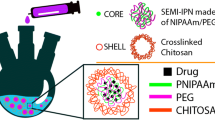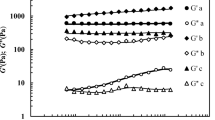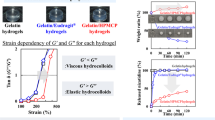Abstract
Purpose. The subject of the study was the influence of hydrodynamic stress on the drug release from direct compressed hydrocolloid embeddings. Additionally a correlation between the release kinetics and different polymer characterising parameters was attempted.
Methods. The drug release was fitted to an expanded Korsmeyer equation to describe the release kinetics. The influence of the stirring rate of the paddle in the USP paddle apparatus on the Mean Dissolution Time (MDT) was expressed as quotient of the MDT's at the stirring rate of 200 and 100 min−1.
Results. If the drug release followed the square root of time kinetics, nearly no effect of the agitation speed on the release rate was observed. To achieve this diffusion controlled drug release the developing gel layer had to be hydrated very well and resistant against erosion (viscosity of at least 4000 mPa · s of the 2% polymer solution and a small expansion of the swelling gel especially at the beginning of the release). The erosion controlled zero order release was generally much affected by the hydrodynamic stress except for some hydrocolloids with incomplete swelling. Thus, it was possible to define a new release mechanism, the polymer particle erosion. The drug release was controlled by the attrition of partially swollen polymer particles and not by the polymer dissolution or drug diffusion.
Conclusions. Polymer particle erosion or diffusion control should be the release controlling mechanisms for negligible influence of hydrodynamic stress.
Similar content being viewed by others
REFERENCES
H. Lapidus, N. G. Lordi. Drug release from compressed hydrophilic matrices. J. Polym. Sci. 57: 1292–1301 (1968)
W. D. Lindner, J. E. Möckel, B. C. Lippold. Controlled release of drugs from hydrocolloid embeddings. Eur. J. Pharm. Biopharm. in press
J. L. Ford, M. H. Rubinstein, J. E. Hogan. Propranolol hydrochloride and aminophylline release from matrix tablets containing hydroxypropyl-methylcellulose. Int. J. Pharm. 24:339–350 (1985)
L. S. C. Wan, P. W. S. Heng, L. F. Wong. Relationship between swelling and drug release in a hydrophilic matrix. Drug Dev. Ind. Pharm. 19:1201–1210 (1993)
J. E. Möckel, B. C. Lippold. Zero-order drug release from hydrocolloid matrices. Pharm. Res. 10:1066–1070 (1993)
T. Higuchi. Mechanism of sustained action medication. J. Polym. Sci. 52:1145–1149 (1963)
W. I. Higuchi. Analysis of data on the medicament release from ointments. J. Pharm. Sci. 51:802–804 (1962)
S. K. Baveja, K. V. Ranga Rao, D. Padmalatha. Zero-order release hydrophilic matric tablets of β-adrenergic blockers. Int. J. Pharm. 39:39–45 (1987)
K. V. Ranga Rao, D. Padmalatha. Swelling controlled-release systems recent developments and applications. Int. J. Pharm. 48:1–13 (1988)
P. Colombo, A. Gazzaniga, C. Caramella, U. Conte, A. La Manna. In vitro programmable zero-order release drug delivery system. Acta Pharm. Technol. 33:15–20 (1987)
J. E. Möckel. Mechanismus kontinuierlicher und gepulster Arzneistofffreisetzung aus Hydrokolloidmatrices Ph.D. thesis, Düsseldorf 1989
W. Lindner. Hydrodynamikunabhängigkeit der Arzneistofffreisetzung aus nichtionischen Hydrokolloideinbettungen insbesondere löslichen Celluloseethern. Ph.D. thesis, Düsseldorf 1994
R. W. Korsmeyer, R. Gurny, E. Doelker, P. Buri, N. A. Peppas. Mechanisms of solute release from porous hydrophilic polymers. Int. J. Pharm. 15:25–35 (1983)
N. A. Peppas. Analysis of fickian and non-fickian drug release from polymers. Pharm. Acta Helv. 60:110–11 (1985)
D. Voegele, D. Brockmeier, H. M. von Hattingberg, B. C. Lippold. Die mittlere Auflösezeit—ein Parameter zur Prüfung von Liberationsbedingungen auf Vergleichbarkeit. Acta Pharm. Technol. 29:167–174 (1983)
Author information
Authors and Affiliations
Rights and permissions
About this article
Cite this article
Lindner, W.D., Lippold, B.C. Drug Release From Hydrocolloid Embeddings with High or Low Susceptibility to Hydrodynamic Stress. Pharm Res 12, 1781–1785 (1995). https://doi.org/10.1023/A:1016238427313
Issue Date:
DOI: https://doi.org/10.1023/A:1016238427313




